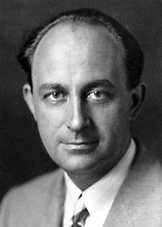Origin Story
It all started with the discovery
of fission by Enrico Fermi in 1934. When he bombed uranium
with neutrons, the resulting elements were much lighter than
Fermi expected. Four years later, Otto Hahn and Fritz
Strassman fired neutrons sourced from radium and beryllium
into uranium-92. As a result, they too discovered they got
much lighter elements than expected, such as barium-56. When
Lise Meitner saw Hahn and Strassman's research, she summed the
mass of the leftover elements to test her theory that it was
the uranium splitting. However, the total mass didn't equal
the mass of the uranium. Meitner then decided to use
Einstein’s theory, E=mc^2, to show that part of the mass had
turned into energy. Not only did this show that fission
occurred, it also proved Einstein’s theory.

Image from Nobel Prize of Enrico Fermi
The World's First Nuclear Reactor
Now that they had a power source,
they needed to find a way to make it self-sustaining.
Scientists believed that if enough uranium was brought
together under the proper conditions they would create a
self-sustaining chain reaction. The amount of uranium needed
is referred to as critical mass. On December 2nd,
1942 on the floor of a squash court at the University of
Chicago, the world's first nuclear reactor was created. The
uranium was encased in graphite and also contained control
rods made of cadmium. The graphite was used as a neutron
moderator. “Fermi had discovered that collisions between
neutrons and neutron moderators can slow he neutrons down, and
thereby make them more likely to be captured by uranium
nulclei causing the uranium to fission.” (Wikipedia) Cadmium
is a metallic element that absorbs neutrons and thus reducing
the number of neutrons for fission. Once the experiment was
under way, the control rods where gradually pulled out a few
inches at a time until they were free.

Image from Atlas Obscura of Pile 1